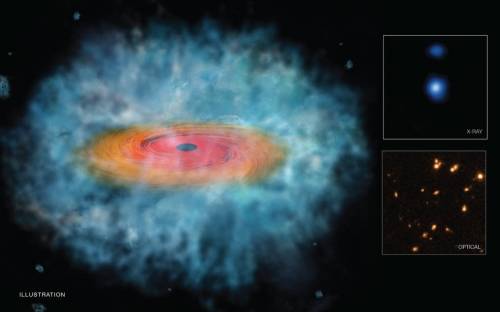 Close Topic Options
Close Topic OptionsBlack Hole - Page 4 of 7
Our galaxy's black hole is spewing - Page 4 - Sciences, Education, Art, Writing, UFO - Posted: 12th Jan, 2017 - 11:26am
Black Hole - Page 4
NASA Telescopes Find Clues For How Giant Black Holes Formed So Quickly
“Our discovery, if confirmed, explains how these monster black holes were born,” said Fabio Pacucci of Scuola Normale Superiore (SNS) in Pisa, Italy, who led the study. “We found evidence that supermassive black hole seeds can form directly from the collapse of a giant gas cloud, skipping any intermediate steps.” Ref. Source 6e
Image from NASA.

Black Hole (Hover)
Black Hole UFO & Writing Art Education Sciences
From what I read (Which admittedly was just the abstract), these 'seed' black holes are formed from the rapid expansion of the universe when the big bang happened. So they are neither a collapsed star nor formed from the surrounding gas. After they were formed (By this rapid expansion), they then sucked up a bunch of gas and such to become super massive black holes (Z>6). Current models have an unrealistically large star being the cause of such black holes, but this model predicts they were formed just after the universe and then sucked up lots of material to become so massive.
Page 4 Hole Black
Algorithm could construct first images of black holes
A new algorithm that could help astronomers produce the first image of a black hole has been constructed by scientists. The algorithm would stitch together data collected from radio telescopes scattered around the globe, under the auspices of an international collaboration called the Event Horizon Telescope. The project seeks, essentially, to turn the entire planet into a large radio telescope dish. Ref. Source 1n.
Hole Black
Scientists observe supermassive black hole feeding on cold gas
For the first time, astronomers have detected billowy clouds of cold, clumpy gas streaming toward a black hole, at the center of a massive galaxy cluster. The clouds are traveling at speeds of up to 355 kilometers per second -- that's almost 800,000 miles per hour -- and may be only 150 light years away from its edge, almost certain to fall into the black hole, feeding its bottomless well. Ref. Source 5s.
Black Hole
Do black holes have a back door?
One of the biggest problems when studying black holes is that the laws of physics as we know them cease to apply in their deepest regions. Large quantities of matter and energy concentrate in an infinitely small space, the gravitational singularity, where space-time curves towards infinity and all matter is destroyed. Or is it? A recent study suggests that matter might in fact survive its foray into these space objects and come out the other side. Ref. Source 4z.
Black Hole - Page 4
Number of known black holes expected to double in two years with new detection method
A method that will detect roughly 10 black holes per year has now been developed, doubling the number currently known within two years, say scientists. They add that it will likely unlock the history of black holes in a little more than a decade. Ref. Source 7u.
Black Hole Sciences Education Art Writing & UFO - Page 4
Our galaxy's black hole is spewing out planet-size 'spitballs'
Every few thousand years, an unlucky star wanders too close to the black hole at the center of the Milky Way. The black hole's powerful gravity rips the star apart, sending a long streamer of gas whipping outward. That would seem to be the end of the story, but it's not. New research shows that not only can the gas gather itself into planet-size objects, but those objects then are flung throughout the galaxy in a game of cosmic 'spitball.' Ref. Source 2k.
 TOPIC: Black Hole
TOPIC: Black Hole Black Holes - Dark Stars - A power unleashed in space that is not worth getting close to.
Black Holes - Dark Stars - A power unleashed in space that is not worth getting close to.